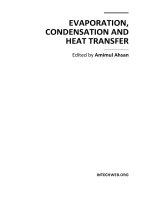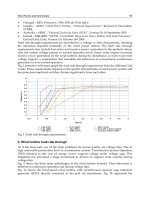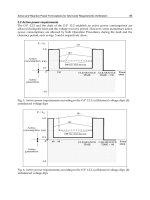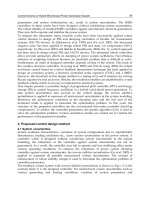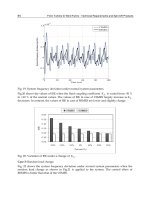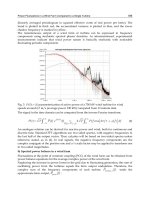From Turbine to Wind Farms Technical Requirements and Spin-Off Products Part 1 docx
Bạn đang xem bản rút gọn của tài liệu. Xem và tải ngay bản đầy đủ của tài liệu tại đây (246.61 KB, 15 trang )
FROM TURBINE TO
WIND FARMS ͳ
TECHNICAL REQUIREMENTS
AND SPINͳOFF PRODUCTS
Edited by Gesche Krause
From Turbine to Wind Farms - Technical Requirements and Spin-Off Products
Edited by Gesche Krause
Published by InTech
Janeza Trdine 9, 51000 Rijeka, Croatia
Copyright © 2011 InTech
All chapters are Open Access articles distributed under the Creative Commons
Non Commercial Share Alike Attribution 3.0 license, which permits to copy,
distribute, transmit, and adapt the work in any medium, so long as the original
work is properly cited. After this work has been published by InTech, authors
have the right to republish it, in whole or part, in any publication of which they
are the author, and to make other personal use of the work. Any republication,
referencing or personal use of the work must explicitly identify the original source.
Statements and opinions expressed in the chapters are these of the individual contributors
and not necessarily those of the editors or publisher. No responsibility is accepted
for the accuracy of information contained in the published articles. The publisher
assumes no responsibility for any damage or injury to persons or property arising out
of the use of any materials, instructions, methods or ideas contained in the book.
Publishing Process Manager Katarina Lovrecic
Technical Editor Teodora Smiljanic
Cover Designer Martina Sirotic
Image Copyright brook, 2010. Used under license from Shutterstock.com
First published March, 2011
Printed in India
A free online edition of this book is available at www.intechopen.com
Additional hard copies can be obtained from
From Turbine to Wind Farms - Technical Requirements and Spin-Off Products,
Edited by Gesche Krause
p. cm.
ISBN 978-953-307-237-1
free online editions of InTech
Books and Journals can be found at
www.intechopen.com
Part 1
Chapter 1
Part 2
Chapter 2
Chapter 3
Part 3
Chapter 4
Chapter 5
Chapter 6
Preface IX
Introduction 1
Local Attitudes towards Wind Power:
The Effect of Prior Experience 3
Jacob Ladenburg and Gesche Krause
Power Network Requirements 15
Wind Farms and Grid Codes 17
María Paz Comech, Miguel García-Gracia,
Susana Martín Arroyo and Miguel Ángel Martínez Guillén
Active and Reactive Power Formulations
for Grid Code Requirements Verification 41
Vicente León-Martínez and Joaquín Montañana-Romeu
Empirical Approaches
to Estimating Hydraulic Conductivity 63
Frequency Control of Isolated Power System
with Wind Farm by Using Flywheel
Energy Storage System 65
Rion Takahashi
Control Scheme of Hybrid Wind-Diesel
Power Generation System 77
Cuk Supriyadi A.N, Takuhei Hashiguchi,
Tadahiro Goda and Tumiran
Power Fluctuations in a Wind Farm
Compared to a Single Turbine 101
Joaquin Mur-Amada and Jesús Sallán-Arasanz
Contents
Contents
VI
Input into Power System Networks 133
Distance Protections in the Power System
Lines with Connected Wind Farms 135
Adrian Halinka and Michał Szewczyk
Impact of Intermittent Wind Generation
on Power System Small Signal Stability 161
Libao Shi, Zheng Xu, Chen Wang, Liangzhong Yao and Yixin Ni
Spin-off Products of Offshore Wind Farms 183
The Potential for Habitat Creation
around Offshore Wind Farms 185
Jennifer C. Wilson
Perceived Concerns and Advocated Organisational
Structures of Ownership Supporting
‘Offshore Wind Farm – Mariculture Integration’ 203
Gesche Krause, Robert Maurice Griffin and Bela Hieronymus Buck
Part 4
Chapter 7
Chapter 8
Part 5
Chapter 9
Chapter 10
Pref ac e
Humanity is facing several critical global challenges at the beginning of the 21st cen-
tury. One of which includes the quest for alternative energy resources that mitigate
the dependence on fossil fuels. Whereas fossil fuels are available in situ at all times,
the utilisation of renewal energies has to cope with large temporal fl uctuations rang-
ing from seconds to seasons. The passing shadow of a cloud over solar panels causes
the fastest variability of power output followed by the gustiness of the wind, the rise
and fall of the tides and the seasonal and annual variations of the availability of bio-
logical resources for energy generation. Thus, the kinds of questions being asked of
the research community have changed over the last decades, refl ecting the increasing
awareness of the fi nite nature and the instability of fossil fuel supply.
Capturing wind energy has been widely employed for centuries – i.e. the traditional
windmills of the Netherlands being a signifi cant landscape element for centuries. To
date, the emerging market for wind power energy is experiencing remarkable global
growth rates which aff ect not only the problem of how to technically link these into
existing power systems, but also eff ect deeply rural landscapes and local livelihoods.
In many instances, initial positive local acceptance altered to the contrary, leading to
sometimes strong opposition against the instalment of wind turbines and wind farms
in rural landscapes. Hence, solving this problem requires additional input of econo-
mists and social-political scientists. The emerging interdisciplinary research increased
the understanding and helped to develop adequate solutions to many of the problems
revolving around wind power energy. However, the disciplinary integration and inter-
disciplinary understanding must be much further advanced.
This book is a timely compilation of the diff erent aspects of wind energy power sys-
tems. It combines several scientifi c disciplines to cover the multi-dimensional aspects
of this yet young emerging research fi eld. It brings together fi ndings from natural and
social science and especially from the extensive fi eld of numerical modelling.
Harvesting wind power requires the erection of towers with rotating wings in the
landscape or at sea. Such artifi cial buildings with moving parts modify drastically the
natural views of the panorama. This raises the question of what are the initial neces-
sary societal preconditions and a itudes to erect a wind turbine. Furthermore, new
grid codes are needed that addresses the requirements to allow the integration of the
variable power generated by renewable energy systems into existing power networks.
Several contributions discuss issues revolving around the variable power of a single
X
Preface
wind turbine, which poses high demands on its control, and means of buff er storage.
These technical aspects and problems are enhanced for clusters of turbines in a wind
park and the complexity of safe power transmission of large and variable power from
wind farms over long distances. The book then moves beyond the classical wind farm
aspects and explores potential spin-off products of off shore wind farms. A case in point
is the potential of creation of new marine habitats. Various aspects of making a second-
ary use of the rigid off shore wind turbine basement constructions as anchor device for
aquaculture in the open ocean is discussed in the fi nal chapter.
The actual research questions of the societal challenges raised in this book should be
not only framed and articulated by scientists but more and more with policy makers
and relevant stakeholders, particularly those concerned with adaptation strategies and
sustainable development.
However, one of the major struggles remains how to further defi ne, develop and imple-
ment integrative research that studies, explains and projects the various interactions
within human-environment and renewable energy systems. Although the book does
not provide cast-in-stone solutions to the critical challenges, it outlines the science
needed to address these challenges in the near future. Thus, a be er understanding of
manifold dimensions of wind energy systems is the core aim of this book.
Dr. Gesche Krause
Social Science and Coastal Management
Leibniz Center for Tropical Marine Ecology (ZMT), Bremen,
Germany
Part 1
Introduction
